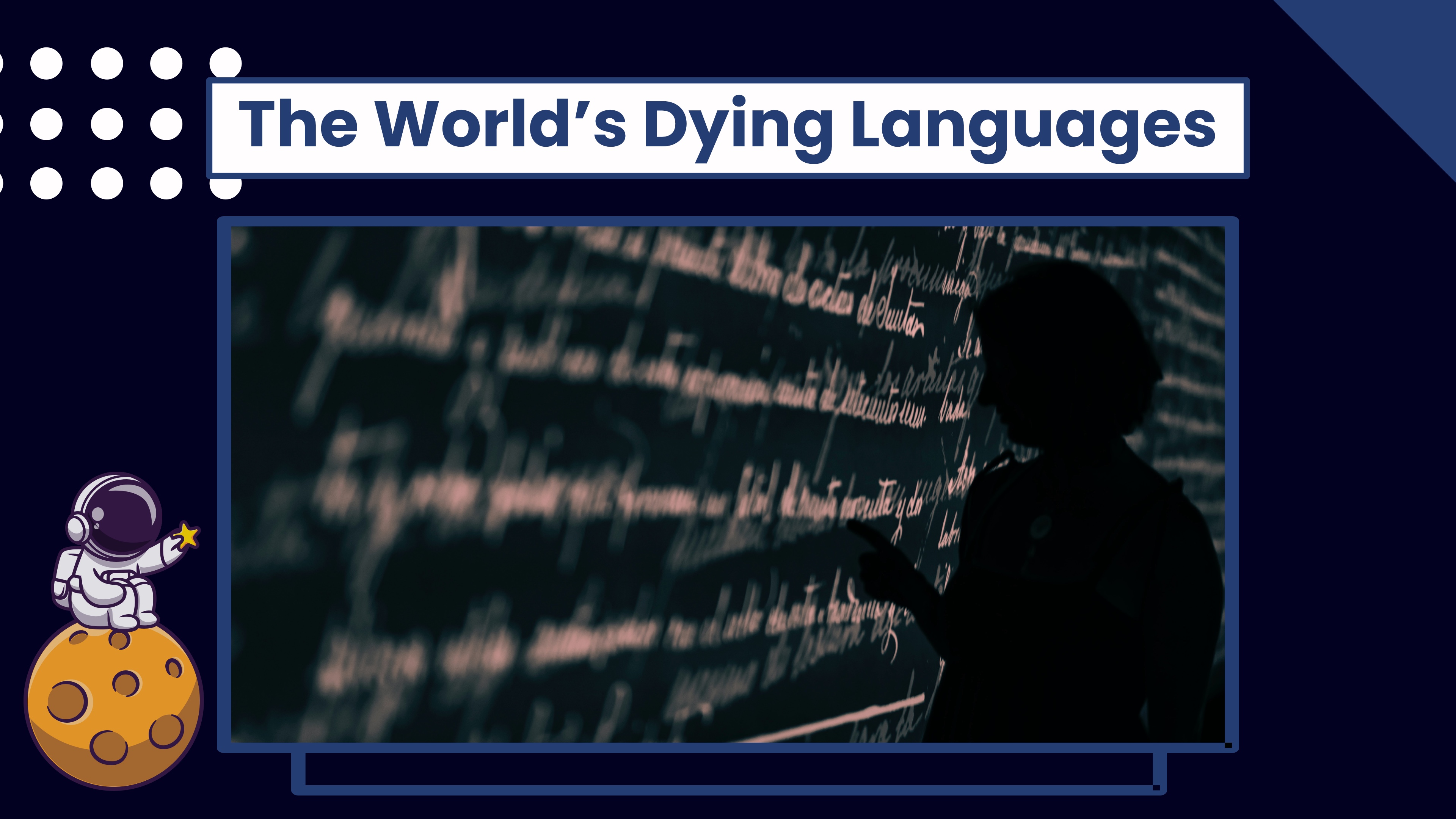
While there were over 9,000 languages in AD 1,000, today there are fewer than 7,000. Statistically, one language dies every two weeks, and forecasts assume that around 3,000 languages will die out in the 21st century. These are still optimistic assessments. Other studies assume a maximum of 100 remaining languages in 2200. One thing is sure: the extinction of languages is advancing at an alarming pace. In addition to the already lost languages (e.g., Latin), there are already so many other languages spoken by so few people that they will no longer exist in the foreseeable future, which leads to a critical situation. The great variety of languages ensures cultural biodiversity and significantly shape the identity of a culture. But when languages that are only spoken by minorities are being pushed back over time, an essential part of their culture vanishes with them. Some die out before they are written down and are therefore difficult or impossible to reconstruct.
UNESCO has taken on this critical fact and published the Atlas "Endangered Languages." One glance is enough to see that there are endangered languages worldwide - even in Europe, where Irish, Sicilian, and Yiddish are affected.
According to the degree of their endangerment, languages are classified by UNESCO in the Language Atlas in six categories. Depending on their distribution (number of speakers), transmission to the next generation, and the language's social status, they are classified as follows:


The UNESCO Language Atlas clearly shows that the languages that are dying out include the indigenous languages in North and Central America and Africa. In Mexico alone, 64 of the 68 languages spoken are threatened with extinction. Of the almost 50 languages in Peru, a large number also show a high degree of risk. Even Quechua, which several million people used to speak in Peru and Bolivia, is in danger. In Africa, more than 350 languages are considered seriously endangered. In Australia, there are over 100 languages on the list.
Even the Kurdish language, which occurs in various countries (e.g., Turkey, Iran, Iraq), was classified as potentially endangered. However, it has a high social status and a relatively high distribution among the Kurds (20 million speakers). Nevertheless, it is not an official language anywhere, since it hardly plays a role in the education systems, which means that the language one of the oldest civilized peoples is on the "red list." Yiddish is also a language that is more than a thousand years old and has spread widely due to the intense emigration of the Jewish population. Today only 3 million people speak it, but it is hardly passed on to the younger generation. UNESCO classifies it as endangered, as well.

Among the nearly 200 languages in Europe, there are also numerous endangered languages. These include many Celtic languages such as Welsh (endangered), Breton (seriously endangered), and Irish (endangered). Although Irish (Gaelic) is an official language in Ireland alongside English and is even one of the 24 official European languages, it can be found on the UNESCO list. It is estimated that only about 44,000 people use Irish as an everyday language. Among the Romance languages, Corsican (potentially endangered), Sardinian (endangered), and Sicilian (endangered) are listed. Sicilian is still spoken by almost 5 million people in Sicily and partly in Apulia and Calabria. However, it hardly plays a role in public life. It is not an official language, and it is not taught in schools. Sicilian is, therefore, a so-called private matter.
UNESCO estimates that dominant languages will replace over 90 percent of the native languages in most regions of the world by the end of the 21st century. This leads to a catastrophic loss of culture, traditions, and values because language always reflects one's own identity. It is the most important means of social contact and acts as a medium through which a community transmits its culture. The close connection between language and culture, which is anchored in the vocabulary, is evident, for example, in the classification of everyday objects and animals and plants. If a language dies out, culture-specific knowledge is also lost. With the death of a language, examples of human thinking and ways of expressing oneself are also lost. In many languages, particular distinctions that we take for granted are missing, or conversely, concepts are expressed in a much more differentiated manner. Languages are also of great value from an anthropological point of view. Today, we know that there's a connection between "Ketic," an almost extinct language of Siberia, and the North American Indians' Navajo languages. This relationship could be evidence of the connection between the Siberian and North American indigenous peoples in human history - a groundbreaking discovery.

The occurrence of languages and their distribution among the world population is impressive. There is a very inhomogeneous picture in the currently 193 countries worldwide. There are still 13 languages in Germany, over 800 in Papua New Guinea, and over 700 in Indonesia. Around 200 languages are spoken in Europe, 180 in the USA, 400 in India, and almost 2,000 in Africa, about 500 of them in Nigeria alone. And within Europe, there is also a big gap. Of the approximately 200 languages, 40 are in the Caucasus.
How did this amount of languages and dialects even emerge? There are different reasons. For example, geographical features play a role. Papua New Guinea has many rugged valleys, and Indonesia has many islands that are separated from each other. This has favored the emergence of independent languages. There were hardly any supra-regional administrations before colonization in many countries that would have forced a uniform language. The individual tribes and population groups formed their own languages. Conversely, the emergence of political structures and globalization led to regionally limited languages being abandoned in favor of a homogeneous linguistic community or a higher-level official language.
It is a natural process for some languages to disappear and new ones to emerge. It has always been there. But what's noteworthy is the increased pace over the past century. Internationally spoken or locally dominant languages are now replacing many languages threatened with extinction. The cultural peculiarities of minorities suffer as a result. The Internet, a product of digitization and globalization, also plays a significant role in the fact that minority languages are in danger of disappearing and, with them, an essential part of the peoples' cultural identity. It would be important that local languages also play a more significant role in public information policy and that niche languages find their way into the public and general acceptance - especially on the Internet. But what if a culture doesn't have an alphabet, like many indigenous and other minority languages? Their transmission takes place only in oral form, and if only older people speak these languages without passing them on to the next generation and, at the same time, have not been written down to this day, threaten to perish in modern times.

To save languages from total extinction, states can enact rules and laws. In Ireland, e.g., Irish has not only been made an official language alongside English, but it is also a compulsory subject in schools. However, there is no Irish daily newspaper, and there are few other media in the Irish language. This limits its use as an everyday language. However, media, books, and all kinds of entertainment are significant in motivating young people to learn a language.
This motivation works best when the community feels strongly connected to the language and combines its history and culture with its language in the present. An example of this is Catalan, which is still actively spoken by more than 11 million people today and is not even on the UNESCO list. This connection with one's language and one's roots is a social task for which everyone must bear the responsibility to succeed. And there are also many efforts to transcribe minority languages that were previously only transmitted orally, to save them from extinction.
Childhood is the best stage of age to bring a person closer to one's culture. Mainly because children learn quickly and, second, it's easier to lay the roots for connectedness at this age. For this reason, there are programs in several countries that bring older people together with children so that they can converse in their own language. Such programs already exist for Maori and also for Frisian, which is even taught in some kindergartens.
It's important to point out the benefits of linguistic diversity and multilingualism regularly. The more languages we learn, the better cognitive skills we have that support us in everyday life and bring us culturally closer to other world regions. That's why it is so crucial to support language communities worldwide and pass on each other's knowledge.

Dive into the world of sign language, an essential communication tool for the hearing-impaired. Explore its linguistic properties akin to spoken languages.
Read →
Unlock a world of opportunities with the benefits of learning a second language. Dive into new cultures, diverse friendships, and exciting career prospects!
Read →
How did humans first begin to communicate with each other? Let's explore the origin of language and how our modern languages have evolved.
Read →